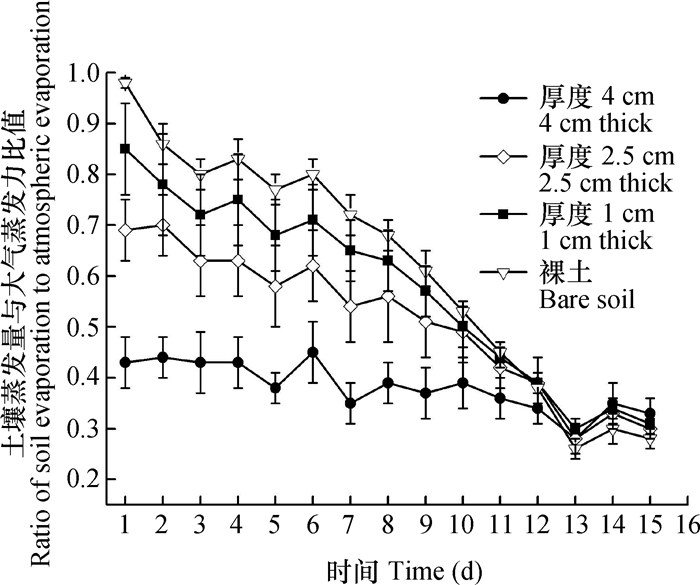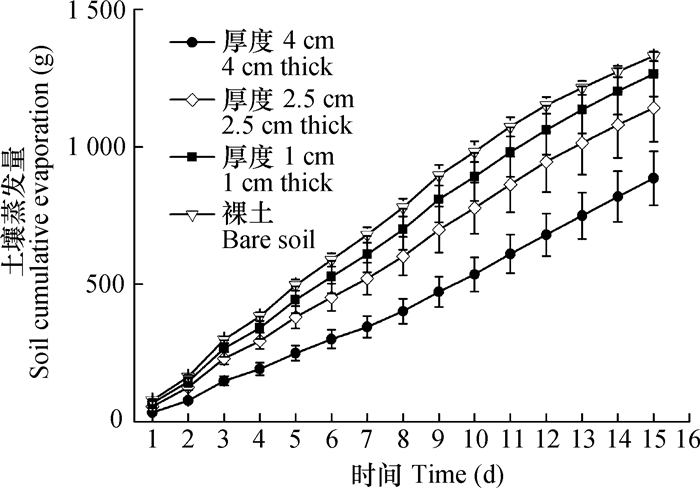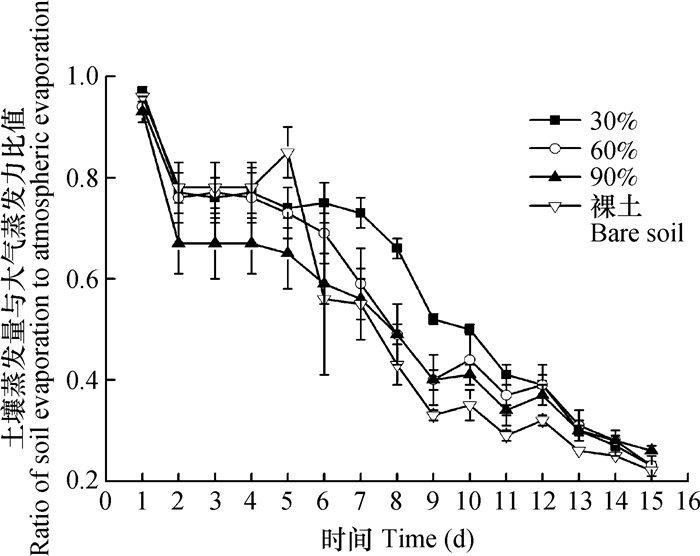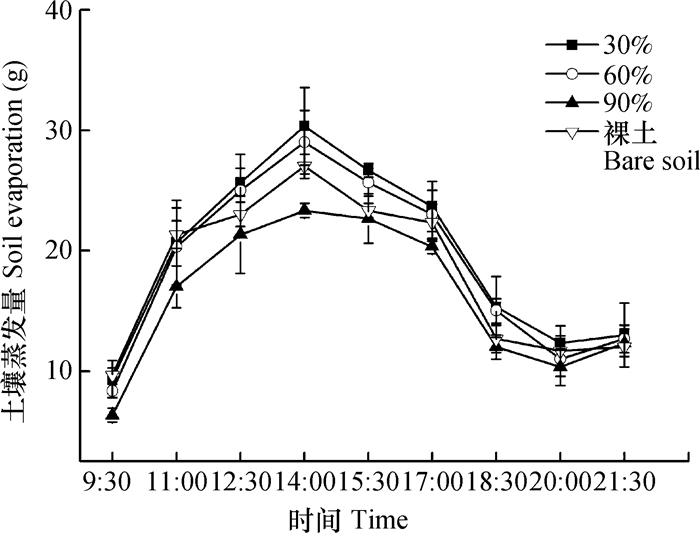2. 中国科学院地理科学与资源研究所生态系统网络观测与模拟重点实验室,北京 100101;
3. 中国科学院大学资源与环境学院,北京 100190
土壤水分蒸发是干旱半干旱区农田水分损失的重要途径,是制约农业生产的关键因素之一[1-2],因此,国内外针对土壤蒸发抑制技术开展了大量研究[3-5]。其中,地表覆盖能够改善农田小气候,在农业生产中受到普遍重视[6]。原翠萍等[7]研究发现,砂石覆盖能够有效抑制土壤蒸发,且抑制能力随砂石粒径的增大而降低;王曼华等[8]通过对秸秆覆盖条件下的盐碱地水分蒸发规律进行分析,指出秸秆覆盖可显著减少土壤水分蒸发,并且能够抑制土壤返盐;周宏伟等[9]利用自然覆盖物进行了人工模拟蒸发实验,结果表明,积沙层、盐结皮层和枯落物阻隔土壤蒸发作用明显;毛学森和曾江海[10]将水泥硬壳应用于农田,可使土壤蒸发减少75%~81%。
蚯蚓是土壤中的主要动物类群,在土壤表面和土体内部可产生大量排泄物——蚯蚓粪,蚯蚓粪是土壤中优良的团粒结构,能够改善土壤的通气透水、蓄水保肥等性质[11-12]。近年来,蚯蚓养殖业逐渐发展壮大,蚯蚓粪被广泛用于育苗、土壤培肥、重金属污染修复以及抑制作物病害等方面[13, 17]。但目前国内外针对蚯蚓粪的研究主要集中于土壤生物、化学等过程,而关于其对土壤物理过程的影响研究较少。已有研究表明,覆盖于地表的蚯蚓粪能够增加土壤表面的粗糙度进而影响水分入渗过程[18-19],但尚未有相关研究分析蚯蚓粪覆盖对土壤蒸发过程的影响。
本研究主要目的是探究蚯蚓粪覆盖对土壤蒸发过程的影响。通过比较一定时段内不同覆盖厚度和覆盖度条件下的土壤蒸发量和土壤累计蒸发量,以及蒸发过程中蚯蚓粪和土壤中有机质含量变化,分析蚯蚓粪不同覆盖条件对土壤蒸发过程的抑制作用,试图揭示蚯蚓粪抑制土壤蒸发的机制。
1 材料与方法 1.1 试验材料试验于2017年6月15日至7月25日在陕西省杨凌区中国科学院水土保持研究所(108°07′E, 34°30′N)试验地进行。供试土壤类型为褐土类,塿土亚类。采自水土保持研究所试验农地,去除表层杂质后,采集0~1 m的土壤样品。土壤样品清除根系等杂质后自然风干,过2 mm筛备用。有机质含量5.36 g kg-1,全氮0.81 g kg-1,颗粒组成为:砂粒5.92%,粉粒62.85%,黏粒31.23%。
试验用蚯蚓粪由大平1号蚯蚓产生,具体收集方法为:蚯蚓加入磨碎的树叶中,放置于温度20℃、土壤水分含量10%~15%的条件下培养1个月,然后在表层收集蚯蚓粪,混合均匀后待用。蚯蚓粪有机质含量18.92g kg-1,全氮8.77 g kg-1,全磷6.23 g kg-1,颗粒组成为:砂粒19.78%,粉粒59.69%,黏粒20.53%。
1.2 试验方法试验用小型蒸发器为内径20 cm、壁厚0.5 cm、高25 cm的圆柱形聚氯乙烯(PVC)管,底部均匀分布6个直径为0.4 cm的圆孔,垫上滤纸及纱布防止土壤漏出。风干塿土按容重1.3 g cm-3分层装入桶内至20 cm厚。将填装好的蒸发器摆放于水槽中,蒸发器底部垫上2 cm厚的塑料泡沫,然后向水槽中缓缓加水至约蒸发器10 cm高处。24 h后,当蒸发器内的土壤全部湿润时,将蒸发器搬出水槽,并在其表面覆盖一层塑料薄膜防止蒸发,静置48 h排除重力水后称重。试验统一将土壤初始含水量控制在田间持水量附近,在自然条件下进行连续蒸发。试验中用称重法测定土壤蒸发量,用20 cm标准蒸发皿测定相同时段内的大气蒸发,标准蒸发皿放置于距离地面75 cm处。在蒸发器的土层上按不同厚度和覆盖度(蚯蚓粪覆盖面积与土壤横截面积之比)随机分散铺设蚯蚓粪,共设置7个处理(见表 1)。铺设完毕后称重记录。在土壤表层垂直插入电子温度计探头,深度为3 cm,用于测定土壤表层温度。每个处理设置3个重复。
|
|
表 1 试验处理 Table 1 Experiment treatment |
装土完成后,将蒸发器放置于户外空旷地,并用遮雨棚对蒸发器进行遮盖以避免降雨影响。蚯蚓粪不同厚度和覆盖度对土壤蒸发量影响的试验分别进行,均连续测定15 d的土壤蒸发量,每天早晨8:00对蒸发器进行称量,同时记录土壤温度和大气蒸发力。同时,在蒸发试验的第1天每隔1.5 h称重,8:00开始至21:30结束,用于分析蚯蚓粪覆盖对土壤蒸发量日变化的影响。
蒸发试验开始前,从收集的蚯蚓粪中随机选取4份重约1 g的团聚体,风干后过2 mm筛,利用重铬酸钾加热法分别测定其有机质含量,取平均值作为蚯蚓粪有机质含量。土壤连续蒸发试验结束后,收集各处理土壤表面的蚯蚓粪并将剩余的土壤混合均匀,分别测定蚯蚓粪及各处理土壤有机质含量。
1.3 数据处理采用Microsoft Excel 2007和SPSS 22.0计算各变量的描述性统计特征值及单因素方差分析,利用Origin8.5完成制图。
2 结果与讨论 2.1 蚯蚓粪覆盖厚度对土壤蒸发过程的影响土壤蒸发量与大气蒸发力的比值可用于反映不同天气条件下各处理蒸发速率的差异。图 1显示了在不同蚯蚓粪覆盖厚度条件下,各处理土壤蒸发量与大气蒸发力的比值随时间的变化。从图中可以看出,在蒸发过程的前9 d,土壤蒸发量表现为覆盖4 cm < 2.5 cm < 1 cm < 裸土,即蚯蚓粪覆盖厚度越大,土壤蒸发量越小;随着蒸发过程的继续进行,不同处理之间的差异逐渐减小。蒸发前期,土壤含水量接近田间持水量,土壤水分充足,蒸发作用强烈,此时,蚯蚓粪覆盖厚度越大,阻碍土壤水分向大气散失的能力越强,因此,蚯蚓粪厚度大的土壤水分蒸发小于厚度小的土壤。以上结果说明:蚯蚓粪覆盖可以有效抑制土壤水分蒸发,且覆盖厚度越大,抑制力越强。随着蒸发过程的进行,土壤中水分不断损失,蒸发强度随着土壤含水量的减少而降低。当地表形成干土层后,水分通过干土层散失至大气中主要是水汽扩散的缓慢过程,蒸发强度很低,受蚯蚓粪覆盖的影响减弱,因此不同处理间无明显差异。

|
图 1 不同覆盖厚度下土壤蒸发量与大气蒸发力的比值 Fig. 1 Ratio of soil evaporation to atmospheric evaporation relative to mulch thickness |
蚯蚓粪不同覆盖厚度对土壤累计蒸发量的影响见图 2。从图中可以看出,随着蚯蚓粪覆盖厚度的增大,土壤累计蒸发量逐渐减少,累计蒸发量与时间近似呈线性关系。覆盖厚度1 cm、2.5 cm和4 cm处理下的平均土壤累计蒸发量分别占大气蒸发量的49.57%、47.61%和36.96%,而裸土的平均累计蒸发量占大气蒸发量的55.48%,表明蚯蚓粪覆盖可有效减少土壤水分散失,而且覆盖厚度越大,土壤蒸发量较裸土减少越多。

|
图 2 不同覆盖厚度条件下土壤累计蒸发量随时间的变化 Fig. 2 Temporal variation of soil cumulative evaporation relative to mulch thickness |
图 3为在蚯蚓粪不同覆盖厚度条件下土壤蒸发量在一天中的变化情况。从08:00至12:30,土壤蒸发强度不断增加,12:30时土壤蒸发量达到最大值,之后大致呈下降趋势。土壤蒸发量受温度影响,温度升高时蒸发量相应增大。大部分时间段蚯蚓粪不同覆盖厚度条件下土壤蒸发量从大到小的排序为:裸土 > 1 cm覆盖 > 2.5 cm覆盖 > 4 cm覆盖。至21:30时,覆盖1 cm、2.5 cm和4 cm蚯蚓粪的平均土壤蒸发量较裸土分别降低了16.91%、38.40%、53.87%。就试验时段的土壤蒸发量变化幅度而言,裸土的变幅(ACK= 20.00 g)和标准差(σCK= 5.84 g)大于有蚯蚓粪覆盖的土壤(A1 = 17.33 g,A2.5 = 13.67 g,A4 = 14.33 g;σ1 = 5.84 g,σ2.5 = 4.62 g,σ4 = 4.64 g),说明蚯蚓粪覆盖的土壤更不易受气象条件等外部因素的影响,同时,蚯蚓粪厚度增加至2.5 cm时,土壤蒸发量的变幅和标准差均随着蚯蚓粪覆盖厚度的增加而降低,2.5 cm覆盖厚度与4 cm差异不显著,说明在一定范围内,蚯蚓粪覆盖厚度越大,土壤蒸发过程受气象条件等外部因素影响越小。总体而言,蚯蚓粪覆盖厚度对土壤蒸发过程存在较显著的影响。

|
图 3 不同覆盖厚度条件下土壤蒸发量日变化 Fig. 3 Daily variation of soil evaporation relative to mulch thickness |
蚯蚓粪不同覆盖度条件下土壤蒸发量与大气蒸发力比值连续15 d的动态变化过程如图 4。从图中可以看出,在蒸发过程的第1天,所有处理的土壤蒸发量均较高,占同期大气蒸发力的91.11% ~ 97.78%,其中,覆盖度90%的土壤平均蒸发量最低(93.09%)。第2天至第4天,不同处理的土壤日蒸发量均变化很小,覆盖度90%的土壤蒸发量显著小于其他三个处理,而裸土的日蒸发量最高。第5天开始,所有处理的土壤蒸发量均呈现明显的下降趋势,不同处理的土壤日蒸发量从高到低依次为:覆盖度30% > 覆盖度60% > 覆盖度90% > 裸土。裸土的蒸发量小于蚯蚓粪覆盖的土壤可能是由于裸土的水分散失较快,其表层发生板结阻碍水分蒸发[20]。而对于覆盖蚯蚓粪的三种处理而言,在覆盖厚度一定的情况下,覆盖面积越大,土壤与大气的接触面积越小,对蒸发的抑制越强,土壤蒸发量越小。

|
图 4 不同覆盖度条件下土壤蒸发量与大气蒸发力的比值 Fig. 4 Ratio of soil evaporation to atmospheric evaporation relative to mulching coverage |
图 5显示了蚯蚓粪不同覆盖度条件下土壤累计蒸发量随时间的变化。由图可以看出,蒸发前期覆盖度90%的土壤累计蒸发量明显小于其他三个处理,但覆盖度30%、60%和裸土的土壤累计蒸发量差异不明显。随着蒸发过程的进行,裸土的累计蒸发量逐渐小于覆盖度30%和60%的处理,但仍高于覆盖度90%的土壤。在蒸发过程的最后4天,裸土的累计蒸发量与覆盖度90%的土壤基本一致。此外,对比覆盖度为90%覆盖厚度分别为2 cm和2.5 cm条件下土壤累计蒸发量变化趋势,可以发现前者的土壤蒸发速率在前9天较高,之后出现明显的降低,而后者的蒸发速率则基本稳定。这主要是由于二者试验同期的气象条件存在差异。对于覆盖厚度2 cm的处理,其试验前期的外界气温高于覆盖厚度2.5 cm的处理,后期则相对较低,因此,土壤水分在蒸发过程前期散失较快,蒸发速率较高,后期由于土壤含水量较低,蒸发速率下降。而对于覆盖厚度为2.5 cm的处理,由于其前期水分损失相对较少,且后期外界气温较高,因此,蒸发速率无明显变化。虽然土壤蒸发过程在相似覆盖条件下存在差异,但均能够有效减少土壤蒸发量。

|
图 5 不同覆盖度条件下土壤累计蒸发量随时间的变化 Fig. 5 Temporal variation of soil cumulative evaporation relative to mulching coverage |
图 6为在不同覆盖度的蚯蚓粪覆盖条件下土壤蒸发量在一天内的变化情况。由图可知,不同处理的土壤在一天中蒸发量先增大后减小,在12:30至14:00最大,8:00至9:30最小。在8:00至11:00之间,土壤蒸发量从高到底依次为:裸土 > 覆盖度30% > 60% > 90%;在11:00之后则为:覆盖度30% > 覆盖度60% > 裸土 > 覆盖度90%。尽管表层板结导致裸土的蒸发量较低,但覆盖度90%的土壤蒸发量仍小于裸土,其在试验时段内的累计蒸发量是裸土的89%。说明当蚯蚓粪覆盖度较大时,对土壤蒸发的抑制作用较为明显。

|
图 6 不同覆盖度条件下土壤蒸发量日变化 Fig. 6 Daily variation of soil evaporation relative to mulching coverage |
蒸发过程结束后各处理土壤的有机质含量见表 2。试验开始时土壤有机质含量为5.36 g kg-1,结束时所有处理的土壤有机质含量均有所下降。其中,无蚯蚓粪覆盖的土壤有机质含量减少了23.32%,高于有蚯蚓粪覆盖的处理,并且土壤有机质减少量随着蚯蚓粪覆盖厚度和覆盖度的增加而减小。分别对蚯蚓粪不同覆盖厚度和覆盖度的土壤有机质含量进行方差分析,可以看出:蚯蚓粪覆盖可显著增加土壤有机质含量。对于覆盖不同厚度蚯蚓粪的土壤来说,当覆盖厚度由1 cm增加至2.5 cm时,土壤中有机质含量显著增加,但当厚度增加至4 cm时,有机质含量无显著性提高。而对于覆盖厚度一定但覆盖度不同的土壤而言,增大蚯蚓粪覆盖度可显著提高土壤有机质含量。
|
|
表 2 不同覆盖条件下蒸发过程结束土壤有机质含量 Table 2 Soil organic matter content after the experiment relative to treatment |
本试验所用蚯蚓粪的有机质含量在蒸发过程开始为18.92 g kg-1,为土壤有机质含量的3.53倍。土壤有机质能够促进团聚体结构的形成,进而改善其吸水和持水能力[21-22]。蚯蚓吞食土壤后形成的团聚体结构疏松,具有较大的毛管孔隙度和较高的有机质含量[23-24],因此,蚯蚓粪较土壤具有更好的保水性能。此外,本研究结果表明,蚯蚓粪的覆盖还能够有效增加土壤有机质含量,在一定程度上也提高了土壤的持水能力。
3 结论蚯蚓粪覆盖对土壤水分蒸发有一定的抑制作用,且与蚯蚓粪的覆盖厚度和覆盖度有密切关系。在相同的覆盖度条件下,土壤蒸发量与大气蒸发力的比值随蚯蚓粪覆盖厚度的增加而减小;土壤累计蒸发量与时间近似呈线性关系,而且覆盖厚度越大,蒸发过程受气象等外界条件的影响越弱,蒸发强度的日变化幅度越小。蚯蚓粪覆盖度对土壤蒸发过程的影响小于覆盖厚度,覆盖度较大时,抑制土壤蒸发的效果较为明显。进一步分析蒸发前后蚯蚓粪和各处理土壤有机质含量的变化,表明蚯蚓粪能够有效增加土壤有机质含量,从而增强土壤的保水、持水性能。
| [1] |
Wallace JS. The measurement and modelling of evaporation from semiarid land . International Association of Hydrological Sciences, 1991, 199: 131-148.
(  0) 0) |
| [2] |
蔡永坤, 李毅, 冯浩. 不同砂石覆盖度和粒径对土壤水分蒸发的影响. 水土保持学报, 2014, 28(6): 273-277. Cai Y K, Li Y, Feng H. Effects of grave-sand mulching degree and size on soil moisture evaporation (In Chinese). Journal of Soil and Water Conservation, 2014, 28(6): 273-277. (  0) 0) |
| [3] |
门旗, 李毅, 冯广平, 等. 地膜覆盖对土壤棵间蒸发影响的研究. 灌溉排水学报, 2003, 22(2): 17-25. Men Q, Li Y, Feng G P, et al. Effects of plastic film mulch patterns on soil surface evaporation (In Chinese). Journal of Irrigation and Drainage, 2003, 22(2): 17-25. (  0) 0) |
| [4] |
Al-Omran A M, Sheta A S, Falatah A M, et al. Effect of drip irrigation on squash (Cucurbita pepo) yield and water-use efficiency in sandy calcareous soils amended with clay deposits . Agricultural Water Management, 2005, 73(1): 43-55. DOI:10.1016/j.agwat.2004.09.019
(  0) 0) |
| [5] |
Li T, Shao M, Jia Y. Characteristics of soil evaporation and temperature under aggregate mulches created by burrowing ants . Soil Science Society of America Journal, 2017, 81(2): 259-267. DOI:10.2136/sssaj2016.08.0259
(  0) 0) |
| [6] |
隋红建, 曾德超. 地面覆盖应用与研究的现状及发展方向. 农业工程学报, 1990, 6(4): 26-34. Sui H J, Zeng D C. Status and trend of application and research on mulch culture (In Chinese). Transactions of the Chinese Society of Agricultural Engineer, 1990, 6(4): 26-34. (  0) 0) |
| [7] |
原翠萍, 张心平, 雷廷武, 等. 砂石覆盖粒径对土壤蒸发的影响. 农业工程学报, 2008, 24(7): 25-28. Yuan C P, Zhang X P, Lei T W, et al. Effects of mulching sand and gravel size on soil moisture evaporation(In Chinese) (In Chinese). Transactions of the Chinese Society of Agricultural Engineer, 2008, 24(7): 25-28. (  0) 0) |
| [8] |
王曼华, 陈为峰, 宋希亮, 等. 秸秆双层覆盖对盐碱地水盐运动影响初步研究. 土壤学报, 2017, 54(6): 1396-1400. Wang M H, Chen W F, Song X L, et al. Preliminary study on effect of straw mulching and incorporation on water and salt movement in salinized soil(In Chinese) (In Chinese). Acta Pedologica Sinica, 2017, 54(6): 1396-1400. (  0) 0) |
| [9] |
周宏伟, 李生宇, 孙树国, 等. 自然覆盖物对塔里木沙漠公路防护林土壤蒸发的影响. 科学通报, 2008, 53(s2): 123-130. Zhou H W, Li S Y, Sun S G, et al. Effect of natural cover on soil evaporation of tarim desert highway shelterbelt (In Chinese). Chinese Science Bulletin, 2008, 53(s2): 123-130. (  0) 0) |
| [10] |
毛学森, 曾江海. 硬覆盖对土壤水热传输及作物生长发育影响的试验研究. 生态学杂志, 2000, 19(2): 68-71. Mao X S, Zeng J H. A study of effects of the concrete mulch on movement of soil water and soil heat transfer (In Chinese). Chinese Journal of Ecology, 2000, 19(2): 68-71. (  0) 0) |
| [11] |
胡艳霞, 孙振钧, 程文玲. 蚯蚓养殖及蚓粪对植物土传病害抑制作用的研究进展. 应用生态学报, 2003, 14(2): 296-300. Hu Y X, Sun Z J, Cheng W L. Advances in vermiculture and inhibition of vermicompost to soil-borne disease(In Chinese) (In Chinese). Chinese Journal of Applied Ecology, 2003, 14(2): 296-300. (  0) 0) |
| [12] |
王凤艳. 蚯蚓粪对土壤的影响. 吉林农业, 2005(10): 25. Wang F Y. Effects of earthworm cast on soil (In Chinese). Agriculture of Jilin, 2005(10): 25. DOI:10.3969/j.issn.1674-0432.2005.10.028 (  0) 0) |
| [13] |
李扬, 乔玉辉, 莫晓辉, 等. 蚯蚓粪作为土壤重金属污染修复剂的潜力分析. 农业环境科学学报, 2010, 29(s1): 250-255. L iY, Qiao Y H, Mo X H, et al. Analysis for earthworm feces as one of potential repair agent of heavy metal contamination in soil(In Chinese) (In Chinese). Journal of Agro-Environment Science, 2010, 29(s1): 250-255. (  0) 0) |
| [14] |
Capowiez Y, Dittbrenner N, Rault M, et al. Earthworm cast production as a new behavioural biomarker for toxicity testing . Environmental Pollution, 2010, 158(2): 388-393. DOI:10.1016/j.envpol.2009.09.003
(  0) 0) |
| [15] |
王福友, 王冲, 刘全清, 等. 腐植酸、蚯蚓粪及蚯蚓蛋白肥料对滨海盐碱土壤的改良效应. 中国农业大学学报, 2015, 20(5): 89-94. Wang F Y, Wang C, Liu Q Q, et al. Improved effect of humic acid, earthworm protein fertilizer and vermicompost on coastal saline soil (In Chinese). Journal of China Agricultural University, 2015, 20(5): 89-94. (  0) 0) |
| [16] |
滕明姣, 万兵兵, 王东升, 等. 蚓粪施用方式对不同品种番茄生长和土壤肥力的影响. 土壤, 2017, 49(4): 712-718. Teng M J, Wan B B, Wang D S, et al. Effects of vermicompost application modes on growth of two tomato cultivars and soil fertility(In Chinese) (In Chinese). Soils, 2017, 49(4): 712-718. (  0) 0) |
| [17] |
申飞, 郭瑞, 朱同彬, 等. 蚓粪和益生菌配施对设施番茄地土壤线虫群落的影响. 土壤学报, 2016, 53(4): 1016-1023. Shen F, Guo R, Zhu T B, et al. Effect of combined application of vermicompost and probiotics on soil nematode communities in greenhouse tomato field (In Chinese). Acta Pedologica Sinica, 2016, 53(4): 1016-1023. (  0) 0) |
| [18] |
Binet F, Le Bayon R C. Space-time dynamics in situ of earthworm casts under temperate cultivated soils . Soil Biology & Biochemistry, 1998, 31(1): 85-93.
(  0) 0) |
| [19] |
Le Bayon R C, Binet F. Earthworm surface casts affect soil erosion by runoff water and phosphorus transfer in a temperate maize crop . Pedobiologia, 2001, 45(5): 430-442. DOI:10.1078/0031-4056-00097
(  0) 0) |
| [20] |
张景略. 土壤蒸发与抗旱保墒. 中国农业科学, 1962, 3(8): 12-18. Zhang J L. The soil evaporation and soil moisture and drought (In Chinese). Scientia Agricultura Sinica, 1962, 3(8): 12-18. (  0) 0) |
| [21] |
刘效东, 乔玉娜, 周国逸. 土壤有机质对土壤水分保持及其有效性的控制作用. 植物生态学报, 2011, 35(12): 1209-1218. Liu X D, Qiao Y N, Zhou G Y. Controlling action of soil organic matter on soil moisture retention and its availability (In Chinese). Chinese Journal of Plant Ecology, 2011, 35(12): 1209-1218. (  0) 0) |
| [22] |
彭新华, 张斌, 赵其国. 土壤有机碳库与土壤结构稳定性关系的研究进展. 土壤学报, 2004, 41(4): 618-623. Peng X H, Zhang B, Zhao Q G. A review on relationship between soil organic carbon pools and soil structure stability (In Chinese). Acta Pedologica Sinica, 2004, 41(4): 618-623. DOI:10.11766/trxb200308110419 (  0) 0) |
| [23] |
黄福珍. 论蚯蚓对土壤结构形成及性态的影响. 土壤学报, 1979, 16(3): 211-217. Huang F Z. The influence of earthworm on the formation of soil structure (In Chinese). Acta Pedologica Sinica, 1979, 16(3): 211-217. (  0) 0) |
| [24] |
董炜华, 李晓强, 宋扬. 土壤动物在土壤有机质形成中的作用. 土壤, 2016, 48(2): 211-218. Dong W H, Li X Q, Song Y. Role of soil fauna on soil organic matter formation (In Chinese). Soils, 2016, 48(2): 211-218. (  0) 0) |
2. Key Laboratory of Ecosystem Network Observation and Modeling, Institute of Geographic Sciences and Natural Resources Research, Chinese Academy of Sciences, Beijing 100101, China;
3. College of Resources and Environment, University of Chinese Academy of Sciences, Beijing 100190, China
 2018, Vol. 55
2018, Vol. 55


